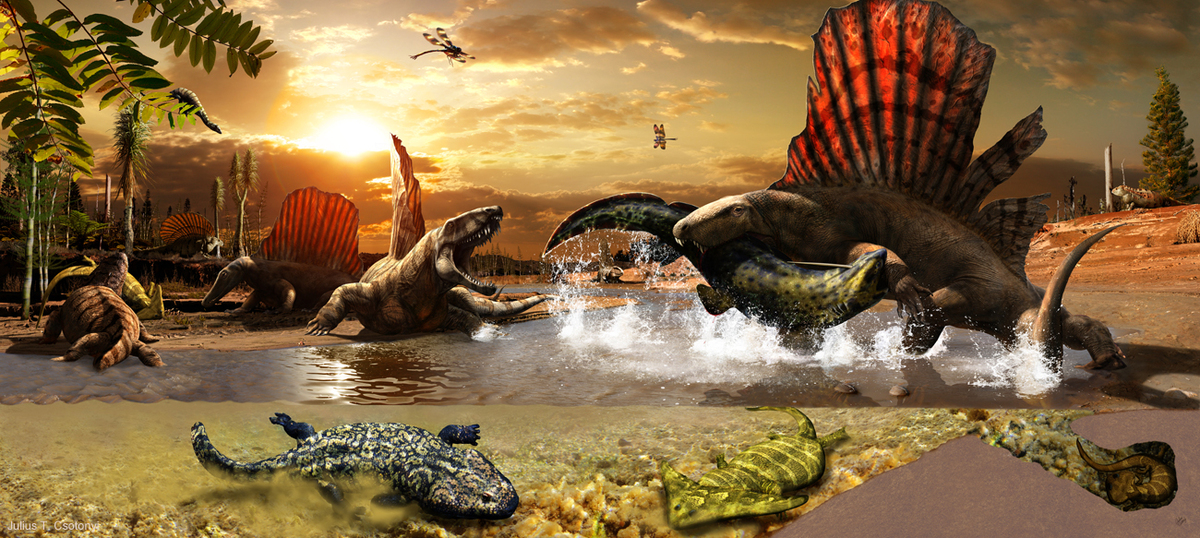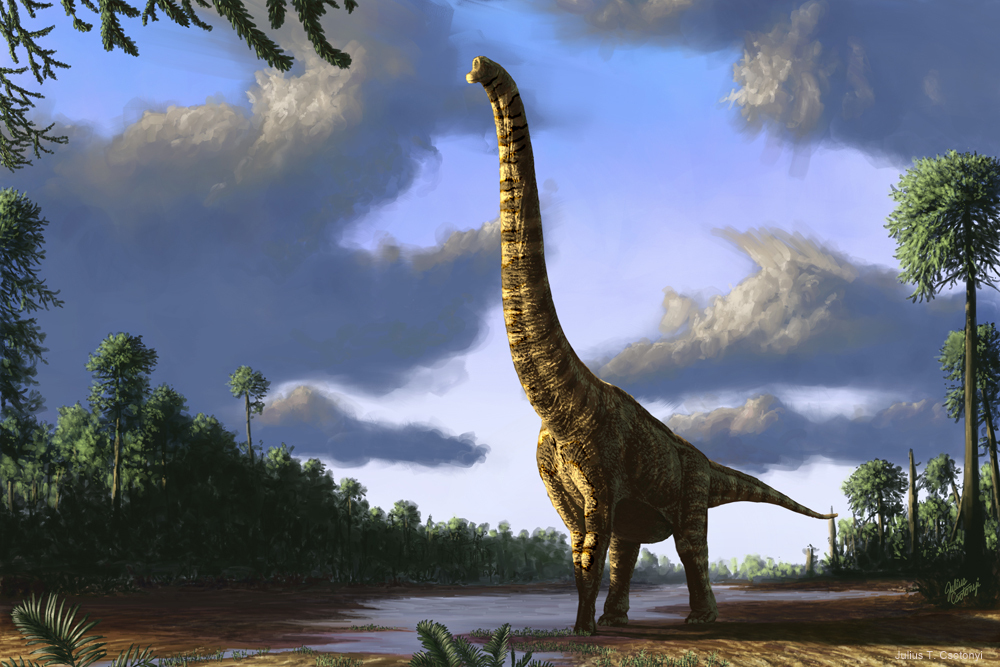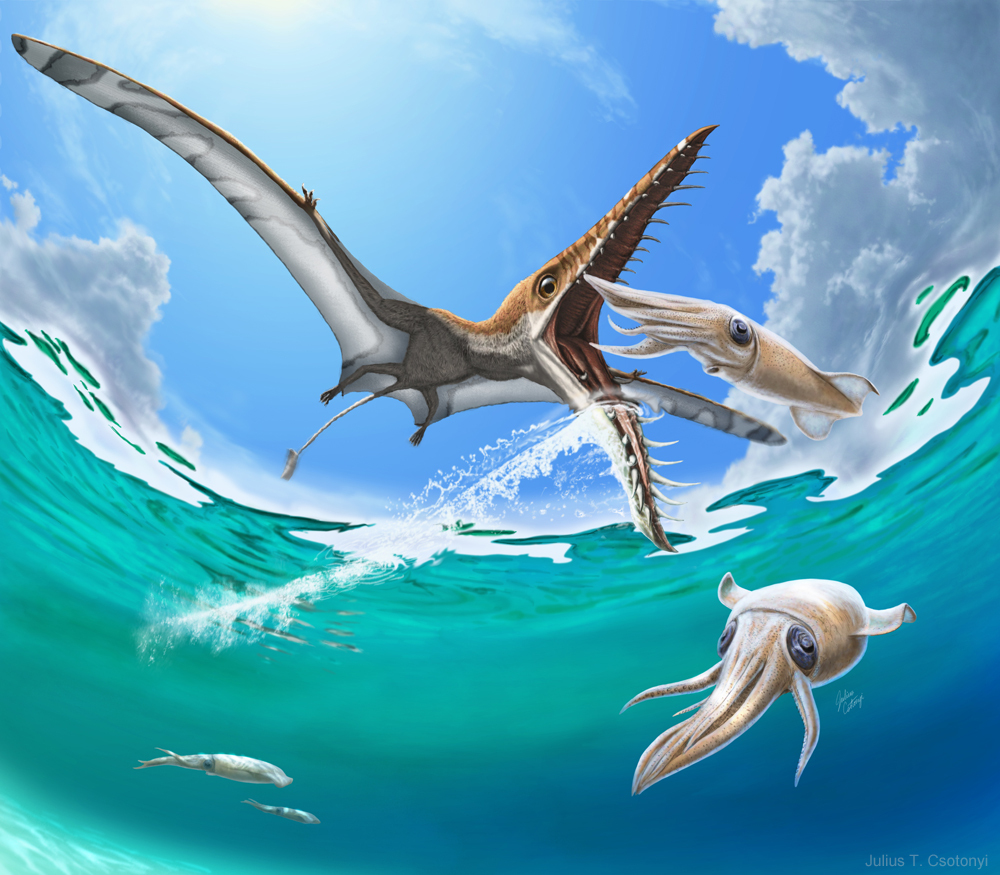The Paleoart of Julius Csotonyi: Dinosaurs, Sabretooths and Beyond (Csotonyi and White 2014) is another palaeoart-focused book from Titan Books, who brought us the acclaimed
Dinosaur Art: the World’s Greatest Paleoart two years ago (White 2012). Anyone familiar with this book will immediately note the very similar format and high production quality in this recent Titan release. Although slightly smaller than
Dinosaur Art, this will - again - leave readers wondering how the extremely affordable price (£25) covers production costs. Csotonyi was, of course, one of the artists featured in
Dinosaur Art but, this time, is entirely running the show. Fans of his work will have little doubt that he can carry an entire book by himself. For the last decade Csotonyi has been establishing himself as one of the world’s premier palaeoartists, illustrating countless press releases, books, articles and museum walls with intricate paintings or digitally-manipulated photograph composites. His work is in such demand that he is one of the few individuals globally who can make a living out of palaeoart, a status which is testament to the quality of his work.
Before we get into the review itself, I want to stress how much of a milestone this book is. Palaeoart and palaeoartists suffer a PR problem where artists are considered
unimportant and interchangeable: individuals who are secondary to the scientists pushing palaeontology forward and the audience who – often superficially – experience their work. Titan Books showed that palaeoart could be tackled more seriously and respectfully with
Dinosaur Art and are cementing this idea in dedicating a whole book to a leading palaeoartists. Csotonyi's position as a working palaeoartist with major publisher support is rather exclusive, but exactly the sort of treatment palaeoart needs. I hope that Csotonyi’s solo album sells well enough to kickstart a series of books featuring other artists. Intentionally or not, Julius’ artwork is a good place to start this hypothetical series: aesthetically pleasing, extremely high quality, and blending traditional palaeoart approaches with some more complex and radical compositions. As a means to test the market for these sort of books, Julius is one of the strongest candidates currently available.
![]() |
| As an industy, palaeoart needs all the help it can get, starting with this logo. |
Right, big-picture stuff out of the way now: what of the book itself? At its most basic level,
The Paleoart of Julius Csotonyi is effectively an expanded version of his chapter from
Dinosaur Art, juxtaposing imagery alongside an interview about Csotonyi’s art, influences and background. The interview, confined to the first 23 of the 156 pages, features intelligent questions and the interesting responses from the artist. Csotonyi’s passion for art and science are clear even before his images are displayed in earnest, as is the amount of work required to produce the large, ultra-high-quality imagery he is famous for. He leaves no doubt that many personal sacrifices are required to work as one of the world’s leading palaeoartists. This section also contains rarely-seen early works and non-palaeontological artwork, including some dedicated to astronomy. Some of the interview responses and other text features words which may be unfamiliar to lay audiences, but a glossary is provided to help readers navigate these terms.
The real meat of the book is relatively text-light so as to provide maximum space for Csotonyi’s art – large format is the only way to appreciate the detail it contains. The art is roughly arranged in chronostratigraphic order, with Palaeoazoic, Mesozoic and Cainozoic subjects separated into different chapters. As usual within palaeoart, the bulk of the artworks depict Mesozoic dinosaurs, and theropods are particularly well represented. Each piece is accompanied by brief details of the composition and commissioners, and some featuring additional comments from scientists about the subject animals. These comments mostly complement Csotonyi’s talents or spin yarns about research associated with the depicted species and, I guess, are designed to boost the scientific content of the book. I do feel a trick has been missed here because none pass particular comment on the decisions made when reconstructing the animals. Seeing as a lot of Csotonyi's art is produced alongside consulting scientists, I’d like to know what input they had. Even the most tightly constrained reconstructions of a fossil animal requires a lot educated guesswork and speculation about palaeobiology and life appearance and - in my own experience at least - not all of this is left to the artist. After all, this is a primarily a book about scientific art, and it seems that these comments could be more insightful than discussions about fossil localities, chance discoveries, or another complement for Julius' artwork (meant with all due respect, of course, but we know he's good. That's why we bought the book!).
![]() |
| A busy day in Permian Texas. Photo composite by Julius Csotonyi, from The Palaeoart of Julius Csotonyi. Image from here. |
Csotonyi himself gives some works longer explanations about the processes involved in the reconstruction. These often highlight works with unusual compositions or viewpoints (such as the excellent ‘fish-eye’ sauropod view) and describes the way each piece was executed, often with alongside draft versions. These provide some insights into his process and will doubtlessly be useful to budding artists. My personal take-home message from these is the exhaustive consideration and research required to understand not only fossil animals, but to also reproduce realistic landscapes and lighting, particularly when odd perspectives and water are involved.
On the art itself: Csotonyi’s images are created using a range of media, including traditional and digital painting, sketches and – most commonly – digital photographic manipulation. I’m going to come clean here and admit that I’m not enormously fond of photographic manipulation. Many such works often fall into palaeoart’s own variant of the ‘uncanny valley’ or, all too often, present oddly-proportioned, strangely posed creatures which have little in common with their known anatomy. Julius’ photo composites are easily among the best, if not the best, attempts at photo-realistic 2D palaeoart out there however, and present reasonably reconstructed animals at either photo-realistic quality, or within inches of it. Some images, particularly the more ambitious, crowded scenes (fans of ‘a busy day in deep time’-type images are well served here) do bear niggles which jar the illusion, such as animals appearing too sharply defined against the background. To a certain extent, this is unavoidable: photomanipulation is incredibly difficult to pull off even remotely well, and even Csotonyi’s lesser successes are still amazing efforts. There are no overused photographic elements, no blurred skin textures, no cloning of animals to create herds of the same individual. When the photomanipulation does work well – and it frequently does – the effects are nothing short of stunning (e.g. below). The image of the resting
Edaphosaurus on page 33 could easily be mistaken for a genuine, beautifully shot photograph. As with
Dinosaur Art, some panoramic scenes unfold to show enormous vistas stuffed with detail. Many of these fold-outs allow those of us with empty pockets our first detailed look at the many murals Julius has created for North American and Australian museums.
![]() |
| Photo composite Acrotholus audeti and Neurankylus lithographicus by Julius Csotonyi, from The Palaeoart of Julius Csotonyi. Image from here. |
My favourite images in the book are digital paintings (below), such as the dancing
Guanlong, the mothering polycotylid and the ceratopsid portrait gallery on pages 102-103. Not only do these show the trademark Csotonyi attention to detail but they’re wonderfully lit and composed: they feel more ‘of a scene’ than the photo composites. A neat touch is that alternative versions of well-known paintings are sometimes included. I actually prefer the near greyscale version of the
Acheroraptor press release image on page 43 to the original, its dusky palate and the removal of the mammal from the hero animal’s mouth creating an entirely different tone to the more familiar version.
![]() |
| Digitally painted Brachiosaurus by Julius Csotonyi, from The Palaeoart of Julius Csotonyi. Image from here. |
Of course, scientific accuracy is also essential for palaeoartworks to be considered successful. In this respect, the book also delivers. Thoroughly modern reconstructions of fossil subjects are presented: extensively feathered maniraptorans, diverse integuments in other dinosaurs, correctly orientated limbs and so on. In light of
All Yesterdays (Conway et al. 2013), Csotonyi’s approach to extinct animal reconstruction may be considered conservative - there are no outlandish, speculative audacities here in terms of appearance or behaviour. Most of the depicted animal interactions are predatory, and the soft-tissues of the reconstructed species are not especially elaborate. Perhaps this is because nearly all of the artworks were commissioned by researchers and museums, clients who tend to favour safer, more conservative palaeoartworks. We should not lose sight of how progressive even ‘conservative’ modern palaeoart actually is. Many sights now familiar to us would have been considered heretical just a few years ago: Csotonyi shows several tyrannosaurs with variable amounts of feathering in the book with little fanfare, for instance. For dinosaurs at least, it’s becoming harder to produce wholly shocking palaeoart without unreasonably bending palaeontological science or speculating wildly. While Csotonyi’s book may lack the accessory frills, wattles and elaborate behaviours of some modern palaeoart, it acts as a fantastic milestone for how far palaeontology and palaeoart has moved in recent years. Moreover, I do not want to give the impression that the images are not interesting or novel: fishing
Dimetrodon (above),
Polycotylus nuzzling its offspring to the water surface to breathe and reptiles swimming between the dredging fronds of rafting crinoids are just some thought-provoking Csotonyian innovations.
I do have a few issues with some science behind the artwork. I’m told that an unfortunate misunderstanding resulted in the extensive discussion of
Rhamphorhynchus skim-feeding on pages 136-139 (Hone, pers. comm. 2014; above. See the
comment from Julius below for the sull story). This was, in fact, meant to reflect dip-feeding or surface-gleaning. Folks who keep up with pterosaur research will know that skim-feeding habits in flying reptiles has been looked into several times,
consistently found problematic (e.g. Chatterjee and Templin 2004; Humphries et al. 2007; Witton and Naish 2008, 2013), and widely publicised. It’s a surprise and a shame, then, that this idea made it into the book without someone noticing, and particularly so because the science elsewhere is pretty tight. I also wonder if some of the photo composite crocodyliforms are shown with entirely accurate scute patterns, as most seem to have been taken from modern crocodylians – many Mesozoic crocs had very different, often simpler scute morphologies. And while we’re moaning, I do wonder if some more complex images would have benefited from small ‘key’ illustrations demonstrating the position of each animal. This is not only because the animals can be hard to spot in the complex, detailed scenes on offer (this is not meant as a slight – remember that many of the more complex images are intended to be hundreds of times larger on museum walls), but because linking a list of unfamiliar names to specific creatures can be difficult. Individuals intimately familiar with genera of all major vertebrate groups should be OK (they exist, honest), but I suspect they will only make up a fraction of this books audience.
These are only minor issues in the grand scheme of things, however. The intelligence and quality of
The Paleoart of Julius Csotonyi makes it essential for anyone interested in palaeoart, as well as more general aficionados of palaeontology, natural history, or natural history art. I have no doubt that palaeoartists will be keeping a close eye on its success, and hoping that it presents the first of a wave of similar tomes from Titan Books. That’s all to come, though: for the time being,
The Paleoart of Julius Csotonyi cements Csotonyi’s status as a world leader among the current crop of palaeoartists, and this book will only further his success.
References
- Chatterjee, S., & Templin, R. J. (2004). Posture, locomotion, and paleoecology of pterosaurs (Vol. 376). Geological Society of America.
- Csotonyi, J. & White, S. (2014). The Paleoart of Julius Csotonyi: Dinosaurs, Sabre Tooths and Beyond. Titan Books, London.
- Humphries, S., Bonser, R. H., Witton, M. P., & Martill, D. M. (2007). Did pterosaurs feed by skimming? Physical modelling and anatomical evaluation of an unusual feeding method. PLoS biology, 5(8), e204.
- White, S. (2012). Dinosaur Art: the World’s Greatest Paleoart. Titan Books, London.
- Witton, M. P., & Naish, D. (2008). A reappraisal of azhdarchid pterosaur functional morphology and paleoecology. PLoS One, 3(5), e2271.
- Witton, M. P., & Naish, D. 2013. Azhdarchid pterosaurs: water-trawling pelican mimics or" terrestrial stalkers"? Acta Palaeontologica Polonica. (In press).





